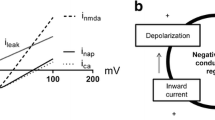Abstract
The passive electrical cable properties of CA3 pyramidal neurons from guinea pig hippocampal slices were investigated by applying current steps and recording the voltage transients from 25 CA3 neurons, using a single intracellular microelectrode and a 3-kHz time-share system. Two independent methods were used for estimating the equivalent electrotonic length of the dendrites, L, and the dendritic to somatic conductance ratio, ρ. The first method is similar to that used by Gorman and Mirolli (1972) and gave an average L of 0.96; the average ρ was 2.44. The second method is derived here for the first time and assumes a finite-length cable with lumped soma. It is an exact solution for L and ρ, using the slopes and intercepts of the first two peeled exponentials. The average L was 0.94; the average ρ was 1.51. The results, using both methods, are in close agreement. The average membrane time constant for all 25 CA3 neurons was 23.6 ms, suggesting a large (23,600 Ωcm2) average membrane resistivity. It is concluded that CA3 neurons are electronically short.
Similar content being viewed by others
References
Andersen, P. (1975). Organization of hippocampal neurons and their interconnections. In Isaacson, R. L. and Pribram, K. H. (eds.),The Hippocampus, Vol. I: Structure and Development, Plenum, New York, pp. 155–175.
Bliss, T. V. P. (1979). Synaptic plasticity in the hippocampus.Trends Neurosci. 242–45.
Bliss, T. V. P., and Lømo, T. (1973). Long-lasting potentiation of synaptic transmission in the dentate area of the anaesthetized rabbit following stimulation of the perforant path.J. Physiol. (Lond.) 232331–356.
Brown, T. H., Perkel, D. H., Norris, J. C., and Peacock, J. H. (1981). Electrotonic structure and specific membrane properties of mouse dorsal-root-ganglion neurons.J. Neurophysiol. 451–15.
Brown, T. H., Wong, R. K. S., and Prince, D. A. (1979). Spontaneous miniature synaptic potentials in hippocampal neurons.Brain Res. 177194–199.
Burke, R. E., and Ten Bruggencate, G. (1971). Electrotonic characteristics of alpha motoneurones of varying size.J. Physiol. (Lond.) 2121–20.
Cole, K. S. (1968).Membranes, Ions and Impulses, University of California Press, Berkeley, Calif., p. 12.
Diamond, J., Gray, E. G., and Yasargil, G. M. (1970). The function of the dendritic spine: an hypothesis. In Andersen, P., and Jansen, J. K. S. (eds.),Excitatory, Synaptic Mechanisms. Universitetsforlaget, Oslo, pp. 213–222.
Fricke, R. A., Brown, T. H., and Prince, D. A. (1979). Electrotonic structure of hippocampal neurons.Neurosci. Abstr. 5502.
Fujita, Y., and Iwasa, H. (1977). Electrophysiological properties of so-called inactivation response and their relationship to dendritic activity in hippocampal pyramidal cells of rabbits.Brain Res. 13089–99.
Gorman, A. L. F., and Mirolli, M. (1972). The passive electrical properties of the membrane of a molluscan neurone.J. Physiol. (Lond.) 22735–49.
Green, J. D. (1964). The hippocampus.Physiol. Rev. 44561–608.
Isaacson, R. L. (1974).The Limbic System. Plenum, New York.
Jack, J. J. B. (1979). An introduction to linear cable theory. In Schmitt, F. O., and Worden, F. G. (eds.),The Neurosciences Fourth Study Program, MIT Press, Cambridge, Mass., pp. 423–437.
Jack, J. J. B., Noble, D., and Tsien, R. W. (1975).Electric Current Flow In Excitable Cells. Oxford University Press, London, pp. 131–224.
Johnston, D. (1979). Passive cable properties of hippocampal neurons.Biophys. J. 25:304a.
Johnston D., and Brown, T. H. (1981). Giant synaptic potential hypothesis for epileptiform activity.Science. 211294–297.
Johnston, D., Hablitz, J. J., and Wilson, W. A. (1980). Voltage clamp discloses slow inward current in hippocampal burst firing neurones.Nature 286391–393.
Kandel, E. R., and Spencer, W. A. (1961a). Excitation and inhibition of single pyramidal cells during hippocampal seizure.Exp. Neurol. 4162–179.
Kandel, E. R., and Spencer, W. A. (1961b). Electrophysiology of hippocampal neurons II. After-potentials and repetitive firing.J. Neurophysiol. 24243–259.
Kandel, E. R., Spencer, W. A., and Brindley, F. J. (1961). Electrophysiology of hippocampal neurons I. Sequential invasion and synaptic organization.J. Neurophysiol. 24225–242.
Lux, H. D., and Pollen, A. (1966). Electrical constants of neurons in the motor cortex of the cat.J. Neurophysiol. 29207–220.
Lux, H. D., Schubert, P., and Kreutzberg, G. W. (1970). Direct matching of morphological and electrophysiological data in cat spinal motoneurons. In Andersen, P., and Jansen, J. K. S. (eds.),Excitatory Synaptic Mechanisms, Universitetsforlaget, Oslo, pp. 189–198.
Perkel, D. H., and Mulloney, B. (1978). Electrotonic properties of neurons: steady-state compartmental model.J. Neurophysiol. 41621–639.
Purpura, D. P., Prelevic, S., and Santini, M. (1968). Hyperpolarizing increase in membrane conductance in hippocampal neurons.Brain Res. 7310–312.
Rall, W. (1957). Membrane time constant of motoneurons.Science 126454–456.
Rall, W. (1962). Electrophysiology of a dendritic neuron model.Biophys. J. 2(suppl.):145–167.
Rall, W. (1969). Time constants and electrotonic length of membrane cylinders and neurons.Biophys. J. 91483–1508.
Rall, W. (1977). Core conductor theory and cable properties of neurons. In Kandel, E. R. (ed.),Handbook of Physiology, Section I: The Nervous System, Williams & Wilkins, Baltimore, Md., pp. 39–98.
Schwartzkroin, P. A. (1975). Characteristics of CA1 neurons recorded intracellularly in the hippocampalin vitro slice preparation.Brain Res. 85423–436.
Schwartzkroin, P. A. (1977). Further characteristics of hippocampal CA1 cellsin vitro.Brain Res. 12853–68.
Spencer, W. A., and Kandel, E. R. (1961a). Electrophysiology of hippocampal neurons. III. Firing level and time constant.J. Neurophysiol. 24260–271.
Spencer, W. A., and Kandel, E. R. (1961b). Electrophysiology of hippocampal neurons IV. Fast prepotentials.J. Neurophysiol. 24272–285.
Steinbach, J. H., and Stevens, C. F. (1976). Neuromuscular transmission. In Llinas, R., and Prech, W. (eds.),Frog Neurobiology, Springer-Verlag, New York, pp. 33–92.
Traub, R. D., and Llinas, R. (1978). Hippocampal pyramidal cells: significance of dendritic ionic conductances for neuronal function and epileptogenesis.J. Neurophysiol. 42476–496.
Wilson, W. A., and Goldner, M. M. (1975). Voltage clamping with a single microelectrode.J. Neurobiol. 6411–422.
Wong, R. K. S., Prince, D. A., and Basbaum, A. I. (1979). Intradendritic recordings from hippocampal neurons.Proc. Natl. Acad. Sci. USA 76986–990.
Author information
Authors and Affiliations
Additional information
This work was supported by Grants NS 11535 and NS 15772 from the National Institute of Neurological and Communicative Disorders and Stroke, National Institutes of Health, U.S. Public Health Service.
Rights and permissions
About this article
Cite this article
Johnston, D. Passive cable properties of hippocampal CA3 pyramidal neurons. Cell Mol Neurobiol 1, 41–55 (1981). https://doi.org/10.1007/BF00736038
Received:
Accepted:
Issue Date:
DOI: https://doi.org/10.1007/BF00736038




